25 Easy Korean Food Recipes You Can Try at Home
Presented here are 25 Korean dishes, which are easy to make in your own kitchen. Some of them can be made without having to buy any special Korean ingredients. All 25 recipes are in this page – you can scroll down or click an item in the list below to quickly jump to a particular section within this page.
When a recipe calls for specialty Korean ingredients, the names of such ingredients are hyperlinked in the recipe. The links will lead to the corresponding sections in our Korean Grocery page, where you can find further information about the ingredients.
If you landed here through a search engine, it is recommended that you begin with our Korean Food Intro page, where the Korean terms for food categories, like “Jeon”, “Namul”, “Jjigae”, etc. are explained.
Bulgogi Recipe
(불고기 : Korean Barbecue)
Moderate Efforts Required
Goes Well with American Meals
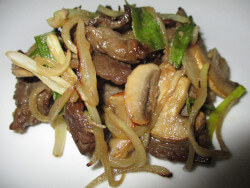
Bulgogi is a grilled beef dish that you can easily make at home without having to buy anything special. The only Asian ingredient you need is soy sauce, which you can find at any American supermarkets these days.
In a Korean restaurant, Bulgogi (Korean BBQ) is cooked over live fire and served with many side dishes and steamed rice. At home, however, you can cook Bulgogi in an oven (at the broil setting) or a pan and enjoy it along with ordinary home-cooked American dishes.
The recipe given below is of course just one of many possible variations, as there are nearly as many Bulgogi recipes as the number of households in Korea. So, feel free to modify the recipe to your liking. Just don’t forget to include soy sauce and sugar, which are essential.
One of the common mistakes beginners make is adding too much soy sauce to Bulgogi. The beef is not supposed to be soaked in full-strength soy sauce. In the marinating mix, the soy sauce must be diluted by roughly the same amount of other liquids; for this purpose, you can use water, white wine or a stock (chicken / beef / vegetable stock).
The first step is to choose beef with nice marbling and slice the beef thinly – ideally you want paper-thin pieces, but that would not be necessary in home cooking. But cutting the beef into cubes or other thick shapes is not a good idea.
Korean BBQ Marinating Mix
For 0.7 - 0.8 pound of beef, mix:
2 Tablespoons of Soy Sauce
1 Tablespoon of White Wine
1 Tablespoon of Water (or Chicken / Beef / Vegetable stock)
1 Tablespoon of Vegetable Oil (or Sesame Oil, for a super-authentic Korean taste)
2 Tablespoons of Sugar
1 Clove of Garlic (minced)
Some Black Pepper
(Optional) Just a Tiny Bit of Ground Ginger
Marination
Add the thinly sliced beef and the marinating mix to a bowl and mix well. Then, add sliced onion (1/2 of a medium-sized one), and optionally, one green onion (sliced) and 2 ounces of mushroom (sliced). Mix them well and keep the whole thing in the refrigerator for at least half an hour.
Cooking
In a preheated oven, broil the marinated beef slices for a few minutes and then flip once to cook the other side too. (Or, you can use the regular, non-broil setting at about 425° F.) Serve immediately.
In case you want a simpler procedure, it is OK to use a pan on a stove top. Oil the pan with vegetable oil and wait until the pan gets hot. Then put only a portion of what you prepared and cook by stir-frying. It’s always a good idea to cook it in several portions, because you don’t want to cool down the pan too much by adding all at once. If you have a barbecue set up, you can of course cook the marinated Bulgogi (Korean BBQ) over barbecue fire.
Beef & Shrimp Jeon
(고기 새우 전 : Gogi Saewoo Jeon)
Moderate Efforts Required
Goes Well with American Meals
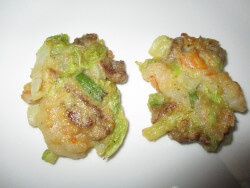
This recipe is not as simple as the other types of Jeon introduced below, but you will find it worth the effort. You need one large leaf of Napa cabbage, which lends a fantastic background taste to this Jeon. (Only Napa cabbage will do. If you don’t have Napa cabbage, just leave it out; don’t use any other kind of cabbage or lettuce).
Cut a Napa cabbage leaf (use 1 large leaf or 2 small leaves) once lengthwise to make two long pieces, and then cut them crosswise into narrow strips, each being less than half an inch wide. Add a generous amount of salt to the cabbage slices and mix them well. Let them sit for about 15 minutes. Water will ooze out of the cabbage pieces, and they will become soft. Now, you want to rinse them well with water so that you won’t eat all that excess salt. After rinsing, squeeze out residual water with your hands and put the cabbage pieces in a bowl. At this point, slice 1-2 green onions and mix them with the cabbage pieces; set the bowl aside.
In this recipe, you will be using both beef and shrimps. You just need a small amount of beef, no more than 0.2 pound (one fifth of a pound), since this is a side dish. Slice beef into small, thin strips and put them in a separate small bowl; add a bit of soy sauce, sugar and black pepper to the beef and mix well. Transfer the seasoned beef strips to the larger bowl which has the Napa cabbage and green onion. Now, you want to prepare shrimps. For this recipe, it’s best to buy unpeeled shrimps and peel them right before cooking. Frozen shrimps are perfectly fine. Take out 4-5 extra-large shrimps (or 3 jumbo shrimps) and partially defrost them in a microwave oven. After peeling, slice the shrimps into strips and add them to the large bowl. Now the large bowl has the beef strips, napa cabbage slices, green onion slices and the shrimp strips.
To this mix, add 2-3 tablespoons of all-purpose flour and one large egg. Combine them well – you are making a batter on the spot this way using the flour and egg. Adjust the consistency of the mix by adding some water. If the batter is too watery, it will be difficult to handle the mix on the pan in the next step, since the nice pellet shape that you want to maintain on the pan will easily collapse. On the other hand, if you use too much flour, handling on the pan may be easier but the final taste will be somewhat bland.
Add vegetable oil in a pan so that the pan is covered with a layer of oil. Set the heat at medium high and wait a couple of minutes. Using two spoons, transfer a tablespoonful of the mix to the pan and shape it into a round pellet. A Korean Jeon is supposed to be eaten in 2-3 bites (like a small American cookie). So, try to form a flat lump roughly in the shape of a cookie (about 1.5 inch in diameter). When you try to form the shape, if the edges of cabbage pieces or shrimp slices stick out, it’s perfectly all right, as long as all ingredients are held together as one lump. Repeat the step until you have several pellets on the pan that are well separated. Flip each pellet a few times until the pellets get golden brown on both sides without burning (if there’s not enough oil on the pan at any point, they may burn). When done, remove from heat. You can enjoy this dish without any sauce. However, you can use soy sauce (original strength, water-diluted, or vinegar-diluted) as a dipping sauce.
Any leftover can be stored in the refrigerator for up to a few days. Before serving, briefly heat the cold Jeon pellets in an oiled pan (flip a couple of times). You can’t have crisp Jeon pellets if you microwave them.
Fish Jeon
(생선 전 : Sangsun Jeon)
Moderate Efforts Required
Goes Well with American Meals
Low in Animal Fat
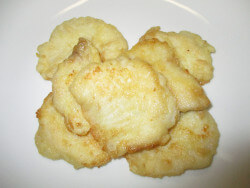
Korea is a peninsula, a long land mass sticking out into the sea, and there are fishing villages throughout the outer periphery of the country. For this reason, Koreans love seafood, and there are incredible “fish markets” in many coastal cities. These are huge market places — not just short stretches of streets — where one can find an endless number of shops selling all kinds of fishes and octopuses, clams, abalones, sea urchins, seaweeds, etc.
You can make delicious Jeon with white meat fishes that are widely available in U.S. supermarkets such as catfish, cod, flounder, tilapia or swai. To make Jeon with a fish, you first need to cut the fish into thin and broad slices, and there is a little trick. It would be easiest if you start with a fillet. Place the fillet on a cutting board and move your knife at a slanted angle (neither vertical nor horizontal but somewhere in between). This way, you can obtain relatively flat slices that are much broader than what you would have gotten if your knife moved just vertically. Yes, the knife should be sharp and you should to be careful with your fingers. Ideally, each slice should be about half the size of a credit card, which you can achieve from the thickest part of a fillet; other pieces may come out smaller. Out of a 0.5 pound of fish fillet, you can typically make about 20 such slices. The fillets of some fish types (e.g., flounder fillets) are already thin enough and you may be able to generate suitable pieces for Jeon simply by cutting them into smaller pieces without worrying about reducing the thickness.
Spread out the fish slices on a plate and sprinkle a small amount of salt (not too much; use the amount you would use over your sunny-side-up egg). You will then need to prepare two bowls: one with flour and the other with egg wash (one scrambled egg mixed with 2-3 tablespoons of water). On a pan, add vegetable oil so that the pan is covered with a thin layer of oil. Set the heat at medium and wait for a few minutes.
Take one fish slice and coat it with flour first and then with egg wash. Transfer it to the pan. Take the next fish slice and repeat this process until the pan is covered with a number of fish slices that are well separated. Flip the fish slices a few times until both sides become golden brown and then remove them from the pan. You can enjoy them without any sauce (especially if you sprinkled an adequate amount of salt at the preparatory step); or you can use soy sauce (original strength or water-diluted) as a dipping sauce.
Zucchini Jeon
(호박 전 : Hobak Jeon)
Easy and Quick
Goes Well with American Meals
No Animal Fat
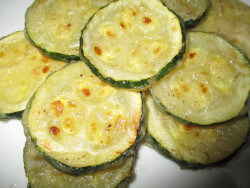
Slice one half of a medium-sized zucchini (or more if you want) into circles. The thickness should be about 1/5 of an inch. Spread them out on the cutting board and sprinkle salt (not too much) and also some black pepper. Rub the zucchini slices together to evenly spread the salt and transfer them to a bowl.
Add a small amount of all-purpose flour (you want to create a batter on the spot). After lightly covering each slice with flour, add a small amount of water, and mix the contents well until each zucchini piece gets covered with flour paste rather than dry flour powder. If you added too much water, the flour mix will become watery and slip away from zucchini; if that happens, you can add a bit more flour to thicken the mix. If you want, instead of making the batter directly on the zucchini slices, you can prepare the batter in a separate bowl.
On a pan, add vegetable oil, so that the pan is covered with a thin layer of oil. Set the heat at medium high and wait a couple of minutes, and then transfer the zucchini slices to the pan. Flip the slices a few times; flipping helps the slices to retain crispness of the flour coat. You are aiming at zucchini pieces that are soft inside and crispy outside.
Remove the slices and serve them. Since salt was already added at the beginning, no dipping sauce is necessary. The flavor of this Jeon complements the tomato sauce of pasta dishes very well. If you want to enjoy it with steamed rice, you can dip the zucchini slices in soy sauce (original strength, water-diluted, or vinegar-diluted).
The original recipe involves dusting each zucchini slice with flour and then coating it with egg wash. The recipe shown here, omitting the egg step, is simpler and results in crispier crusts.
Pan-Fried Tofu
(두부 부침 : Dooboo Boochim)
Easy and Quick
Goes Well with American Meals
No Animal Fat
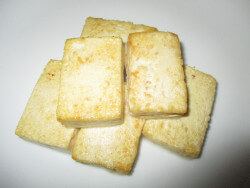
If you like tofu, this recipe is one simple way to cook tofu. It is simply pan-fried tofu, without any batter coating. Dooboo (두부 ; also spelled Dubu) means Tofu in Korean.
About Tofu: tofu is aggregated plant proteins made from soybeans. At a grocery, you can find tofu in a refrigerated section. Many American grocery chains sell tofu nowadays, and Korean groceries definitely have them. The label on a Tofu package will show the firmness class (silken - soft - firm). For the recipe given here, “silken” is recommended, but if you think it’s too difficult to handle (silken tofu breaks easily), you can use the “soft” or "firm" type. Unlike cheese, uncooked tofu can’t be left at room temperature for more than 1-2 hours. When you get home from grocery shopping, put tofu into your refrigerator immediately.
To make tofu Jeon, take out tofu from the package. Discard the original liquid and briefly rinse the tofu with cold water. Slice the tofu into rectangular slices that are no thicker than half an inch. The length and width should be somewhere between 2 and 3 inches. On a pan, add vegetable oil so that the pan is covered with a thin layer of oil. Set the heat at medium high and arrange the tofu slices on the pan for sizzling. Cook for about 3 minutes and then flip the tofu slices to cook for another 2-3 minutes; ideally, each piece should become golden brown on both sides. Remove the tofu slices from heat and serve them. Use soy sauce (original strength or water-diluted) as a dipping sauce.
A Variation: Boiled Tofu
If you are watching calories, you may prefer boiled tofu, which can be made with no oil at all. Boiled tofu has softer texture and tastes great with soy sauce. Put tofu slices in boiling water and wait a few minutes. Remove, drain and serve.
Mung Bean Sprout Namul
(숙주 나물 : Sukju Namul)
Easy and Quick
Goes Well with American Meals
No Animal Fat
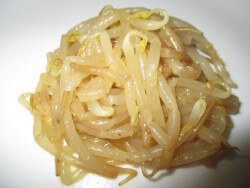
About Mung Bean Sprouts: In the United States, you can find bean sprouts in a refrigerated vegetable section at a Korean (or Asian) grocery. There are 2 types bean sprouts: soybean sprouts and mung bean sprouts (to see the pictures that are in our Korean Grocery page, click the hyperlinks in the next sentences). A soybean sprout has, in its head portion, a prominent yellow bean, which is split into two halves. The head portion of a mung bean sprout is smaller and less conspicuous; in many batches, the bean portions are mostly absent. This recipe will use mung bean sprouts.
Wash mung bean sprouts briefly in cold water. Boil water in a pot. When water starts to boil, add the washed mung bean sprouts. How long you want to leave them in boiling water is up to you. Some people, who prefer crunchiness, blanch mung bean sprouts only for a minute or so; others wait longer to make them softer. Drain water and transfer the sprouts to a bowl. (Do not rinse blanched mung bean sprouts in cold water.) Add one of the following 3 sauces and mix well.
Option 1 (authentic Korean): Soy sauce, crushed sesame and sesame oil.
If you don’t have crushed sesame and sesame oil, you can use Option 2, which is not as authentic but may go better with American meals such as pasta, etc.
Option 2: Soy sauce, vinegar and sugar.
If you like spicy food, try the next option.
Option 3: Soy sauce, vinegar, sugar, plus red pepper flakes (고춧가루 ; Gochugaru in Korean).
Soybean Sprout Namul
(콩나물 : Kong Namul)
Easy and Quick
Goes Well with American Meals
No Animal Fat
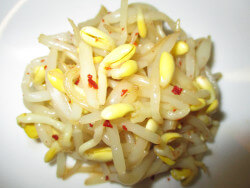
About Soybean Sprouts: In the United States, you can find bean sprouts in a refrigerated vegetable section at a Korean (or Asian) grocery. There are 2 types bean sprouts: soybean sprouts and mung bean sprouts (to see the pictures that are in our Korean Grocery page, click the hyperlinks in the next sentences). A soybean sprout has, in its head portion, a prominent yellow bean, which is split into two halves. The head portion of a mung bean sprout is smaller and less conspicuous; in many batches, the bean portions are mostly absent. This recipe will use soybean sprouts.
Directions for Cooking Soybean Sprouts: Wash soybean sprouts in cold water. Put some water in a pot and bring it to boil. Once the water begins to boil vigorously, add the soybean sprouts to the boiling water and cook them for 5 - 7 minutes. It’s important that the water is boiling vigorously before adding the sprouts. Otherwise (if soybean sprouts are allowed to stay in sub-boiling temperature for a significant amount of time), they will generate a “fishy” smell. Soybean sprouts have special enzymes released at a moderately hot (but below boiling) temperature, leading to a metabolic product that smells “fishy”. To prevent this from happening, make sure that water is already boiling before soybean sprouts are added so that the enzyme will be inactivated immediately. If you need to cook a lot of soybean sprouts, add just one half of what you have into the boiling water, wait for 20 seconds until the water comes back to full boil, and then add the rest. Another important point is that soybean sprouts must be cooked for at least 5 - 7 minutes in boiling water. This is necessary to fully cook the “heads”, the yellow bean portions. After cooking the soybean sprouts for 5 - 7 minutes, drain water and transfer the sprouts to a bowl. (Do not rinse cooked soybean sprouts in cold water.) Add one of the following 3 sauces and mix well.
Option 1 (authentic Korean): Soy sauce, crushed sesame and sesame oil.
If you don’t have crushed sesame and sesame oil, you can use Option 2, which is not as authentic but may go better with American meals such as pasta, etc.
Option 2: Soy sauce, vinegar and sugar.
If you like spicy food, try the next option.
Option 3: Soy sauce, vinegar, sugar, plus red pepper flakes (고춧가루 ; Gochugaru in Korean).
Spinach Namul
(시금치 나물 : Sigeumchi Namul)
Easy and Quick
Goes Well with American Meals
No Animal Fat
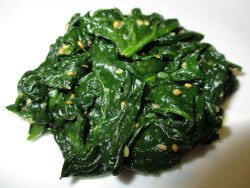
Wash spinach in cold water. Bring water to boil and add spinach, wait about 20 to 30 seconds. Remove from heat and carefully drain the hot water through a strainer. Rinse the spinach with cold running water to cool it down. (Without this step, the delicate spinach leaves will continue to cook in the residual hot water and become too soft.) Squeeze out the water from the spinach with your hands and then loosen the leaves in a bowl. Add one of the following 3 sauces and mix well.
Option 1 (authentic Korean): Soy sauce, crushed sesame and sesame oil. For spinach namul, you need only a small amount of soy sauce. A diluted soy sauce (one part soy sauce and one part water) makes it easier to evenly distribute soy sauce to each of the spinach leaves.
If you don’t have crushed sesame and sesame oil, you can use Option 2, which is not as authentic but may go better with American meals such as pasta, etc.
Option 2: Soy sauce, vinegar and sugar.
If you like spicy food, try the next option.
Option 3 (Hot & Spicy): Soy Sauce, vinegar, sugar, plus one more item, which is red pepper paste (고추장 ; Gochujang in Korean). Note that red pepper paste, rather than red pepper flakes, is used in this recipe.
Bibimbap
(비빔밥 )
Time Consuming and Involved
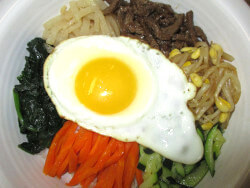
Bibimbap is not a side dish. It is by itself a main meal, because it has steamed rice, beef, vegetables and an egg all in one large bowl.
Restaurant-grade bibimbap is explained in our Korean Restaurant Menu page. The recipe given here is a trimmed down version, which is much easier to simulate in your kitchen. Specifically, we left out Gosari (고사리 : a type of fern, brown in color), which most of our English-speaking readers would have hard time dealing with.
For Bibimbap, prepare a small amount of each of following.
(a) Beef
Cut beef into thin strips, stir fry them in vegetable oil and season with soy sauce, sugar and black pepper.
(b) Soybean Sprout Namul
Prepare soybean sprouts according to the recipe given above in this page (use seasoning Option 1). (If soybean sprouts are not available, you can use mung bean sprouts instead. Prepare them according to the recipe given above in this page (use seasoning Option 1). However, soybean sprouts are much better for this recipe.
(c) Spinach Namul
Prepare according to the recipe given above in this page (use seasoning Option 1).
(d) Carrot
Cut a small amount of carrot into julienne strips and briefly stir fry them on a pan with vegetable oil. Sprinkle some salt.
(e) Zucchini
Cut zucchini into julienne strips and stir fry them on a pan with vegetable oil. Sprinkle some salt.
(f) (optional) Korean Radish
Cut Korean radish into julienne strips and briefly stir fry them on a pan with vegetable oil. Sprinkle some salt.
(g) Fried egg
You need one fried egg, sunny side up, for each serving.
(h) Sauce (Cho-Gochujang: 초고추장 )
Cho-Gochujang is made by mixing red pepper paste (고추장 : Gochujang; details are in our Korean Grocery page), vinegar and sugar. The ratio of the three ingredients is: 2.5 tablespoons of red pepper paste (Gochujang), 1 tablespoon of vinegar and 1 tablespoon of sugar. Note that the numbers given here only show the ratio. The actual amount of Cho-Gochujang you need may vary.
Presentation (in one large bowl per person)
In a large bowl, put one serving of steamed rice. On top of the rice, place a little bit of the items (a) through (f), as shown in the picture. Do not mix – mixing is supposed to be done by the person eating the dish. At the center, place the sunny-side-up egg.
Now your bibimbap is ready. Serve it with a tiny bowl containing the sauce (h), along with a small bottle of sesame oil.
Each person will add 1 or 2 tablespoons of the sauce (h) and a few drops of sesame oil to the bowl before mixing the content.
Japchae
(잡채 )
Time Consuming and Involved
Goes Well with American Meals
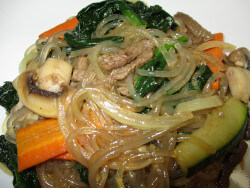
Japchae is a very popular side dish in Korea, and it’s a relatively large side dish. It is essentially “stir-fried vegetables with noodles”. The noodle used in this recipe is “starch noodle” (also known as “cellophane noodle”) (당면 ; Dangmyeon in Korean), which is semi-transparent. It is available in Korean groceries.
To make Japchae, prepare the following items separately and mix them when all the ingredients are cooked and ready.
(a) Vegetables
To Japchae, you want to add spinach, carrot, zucchini, onion, bell pepper (green or red), mushroom, green onion, etc., all cooked and seasoned (do not serve anything raw). Briefly blanch 3-4 ounces of spinach in boiling water, rinse them with cold water, squeeze out the water; then lightly season the spinach with soy sauce. Slice carrot, zucchini, onion and bell pepper into strips (for each of these, use 1/2 of a medium-sized one). Also slice 2 ounces of mushroom and, optionally, 1 green onion; stir-fry these vegetables, one vegetable type at a time (not all of them together), and when cooked, set them aside. Season these vegetables, while cooking them on the pan, with salt and black pepper.
(b) Beef
Cut 0.2 pound of beef into thin strips, stir fry them in vegetable oil and season them with soy sauce, sugar and black pepper.
(c) Dangmyeon (starch noodle)
In boiling water, put 3-4 ounces of dry Dangmyeon (starch noodle) and cook according to the instructions on the package. Drain the cooked noodles and rinse them with cold water. Cut the noodles into short (about 3 inches long) pieces with kitchen scissors or a knife. Season the well-drained Dangmyeon with soy sauce, vinegar and sugar; immediately proceed to the next step.
In a pan, add a generous amount of vegetable oil and stir fry the seasoned Dangmyeon (starch noodles) for a few minutes. To the pan containing the stir-fried Dangmyeon, add back all of the cooked vegetables and the beef for a brief re-heating. During this re-heating step, mix all ingredients in the pan. Taste a portion and, if necessary, add a bit more soy sauce, vinegar or sugar. Add a few drops of sesame oil at the last moment, but it can be omitted if you don’t have sesame oil.
Tteokbokki
(떡볶이 )
Moderate Efforts Required
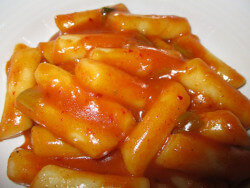
“Tteok” means “rice cake” and “bokki” means “stir-fried”. Tteokbokki (sometimes spelled Tteok-Bokki) is a semi-meal popular in Korea, which is sold at food trucks, snack bars, etc. It’s roughly a cultural counterpart of America’s gas station hot dogs. Long ago, before global fast-food chains showed up in Korea, Tteokbokki was one of the favorite items many Korean school kids enjoyed at cheap eateries, especially those located near the front gates of high schools.
Tteokbokki is a thick stew of rice cakes in a Gochujang (red pepper paste) sauce. To make this, you need the white, tube-shaped Korean rice cakes, which are available at Korean groceries. They come in small plastic packages and are stocked in a refrigerated section. Two other required ingredients are red pepper paste (고추장 ; Gochujang) and red pepper flakes (고춧가루 ; Gochugaru).
Directions: Take out about 1 pound of rice cakes from the package (this amount can be shared by 4 people, if there are other foods on the table). Briefly rinse them with cold water. In a pan, add about 1.5 cups of water; put the rice cakes in the pan and start the heat. The rest of the ingredients described below will be added one by one, while the water in the pan gets heated.
Add about 3 tablespoons of red pepper paste (Gochujang) to the pan and disperse it in the water, which is being heated. To this, add 2 tablespoons of sugar, 1 tablespoon of vegetable oil, 1 teaspoon of soy sauce, and 1 teaspoon of red pepper flakes (Gochugaru).
Once the liquid in the pan starts to boil, add about 1/3 cup of chicken stock. When it starts to boil again, reduce the heat to medium for continued heating. At this point, add green onions (1 or 2 green onions sliced) and a sprinkle of black pepper. It is necessary to stir with a wooden spatula every now and then and scrape the bottom of the pan to make sure that rice cakes don’t stick to the pan. As you continue to cook the rice cakes with occasional stirring, they will become softer and, at the same time, the liquid will thicken because of the starch released from the rice cakes. It will take about 30 - 40 minute of continuous heating over medium heat to achieve the best outcome (the rice cakes fully cooked and the sauce becomes nice and thick), but the exact duration will depend on your heat setting. It’s not a good idea to try to finish the procedure quickly, for example, within 20 minutes, because then the liquid portion would not be as thick as it should be and the rice cakes may not be soft enough. When it’s done, the “liquid” portion in the pan will be very thick.
Special Note: If you want to make Tteokbokki super-authentic, you can add some fish cakes (어묵 : uh-mook). But if you don’t know what Korean fish cakes are, just leave them out. In this recipe, we used chicken stock instead of fish cakes (the original Korean recipe does not use chicken stock). After enjoying Tteokbokki, your mouth will be burning hot. To restore peace in the mouth, some people eat ice cream after Tteokbokki.
Miyeok Soup
(미역국 : Miyeok Guk)
Moderate Efforts Required
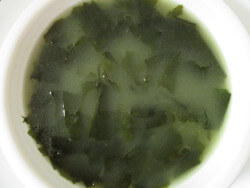
When you cook this uniquely Korean soup made with seaweeds, your kitchen will be filled with a wonderful scent of sea breeze. Every Korean person is supposed to eat this soup on his/her birthday. And, in Korea, this soup is given to mothers who just delivered a baby, as it is believed to be good for recuperation. However, that doesn’t mean that this soup is only a special occasion item. It’s one of the most common everyday home foods.
For this recipe, you will need Miyeok (미역 ), a type of seaweed, which you can buy at Korean groceries. It is packaged in plastic packages in the form of dried clumps.
Key Ingredients (for 2-3 servings)
How to Prepare Miyeok (미역): Take out Miyeok from the package and put it in a large bowl. The amount you need is about half the size of an adult’s fist. Pour 3 cups of cold water. Leave Miyeok in the water for about 20 minutes. The volume of Miyeok will expand greatly in water – you will be surprised (see pictures). Do not discard the water after this step – you will use this water (holding the sea minerals) for the soup. After 20 minutes or so, Miyeok turns into long, soft bands. Using kitchen scissors, cut Miyeok into short pieces (each piece should be shorter than 2 inches). If you don’t have kitchen scissors, you can use a knife, but it's more difficult to cut the slippery Miyeok with a knife. Make sure that there is no long piece remaining. Keep the cut Miyeok in the original water.
Beef: Slice about 0.2 pound (one fifth of a pound) of beef into small pieces. If you want, you can use ground beef.
Shrimps: 3-4 extra-large shrimps or 2-3 jumbo shrimps. Use unpeeled shrimps; frozen ones are fine.
Garlic: 1 clove (sliced or minced)
In a pot, add 1-2 tablespoon of vegetable oil. Wait until the oil heats up and stir fry the beef over high heat. Then, dump the cut Miyeok and the original water used to soak the Miyeok (the volume is about 3 cups of water). Add 3 cups of fresh cold water to bring the total volume in the pot to 6 cups. Add shrimps and heat up the pot. After the water begins to boil, cook at high heat for 10 minutes. Then, turn down the heat to medium, add garlic, and cook for another 10 minutes with the pot covered with a lid. If you have time, you can let it simmer longer, since it will taste better. Season with salt, if necessary, and serve it in a bowl along with Korean-style steamed rice and some side dishes (banchans). Any leftover can be stored in the refrigerator. (Interestingly, the taste of this soup actually gets better after being stored overnight in the refrigerator.)
Special Note: Mussels make a fantastic combination with Miyeok. Mussel-Miyeok soup is a classic Korean food. If you want to add mussels, beef and shrimps should be omitted.
Radish Soup
(무국 : Moo Guk)
Moderate Efforts Required
Goes Well with American Meals
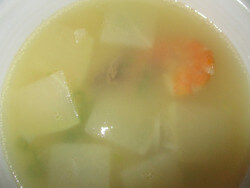
When you try this easy-to-make home-style soup, you will be impressed by the mysterious sweetness, which comes from stir-fried radish. This mild soup goes well with Western foods as well.
Key Ingredients (for 2-3 servings)
Korean Radish (무 ): Slice Korean radish into relatively thin discs first (with a thickness of about 1/8 inch (3 mm). Then cut the discs into roughly 1 inch x 1 inch squares. Prepare about “1 cup” of sliced radish.
Dasima (다시마 ; sea tangle): Dasima is a type of seaweed available at Korean groceries. You need a palm-sized piece.
Beef: Slice about 0.2 pound (one fifth of a pound) into small pieces. If you want, you can also use ground beef.
Shrimps: 3 -4 extra-large shrimps or 2-3 jumbo shrimps (unpeeled). Frozen ones are fine.
Onion: Cut one half of a medium-sized onion into small pieces.
Green onion: Chop one green onion.
Garlic (optional): 1 small clove (or one half of a large clove) of garlic (sliced or minced)
In a pot, add 2 - 3 tablespoons of vegetable oil. Wait until the oil heats up and then stir fry the radish pieces for about 2 minutes over high heat. At this point, you will have a mixture of oil, water (from the radish) and the radish pieces in the pot. To the mix, add the sliced beef and cook at high heat until the beef is cooked. Now, to the same pot, add 5 cups of cold water, the sliced onion, shrimps, Dasima, and optionally, a few grains of whole black pepper. Bring the pot to boil. Once boiling, reduce the heat to medium, cover the pot with a lid and continue cooking for 10 minutes.
Remove and discard the Dasima piece (Dasima is used for extracting the flavor only and should not be served in the final soup). Then, add sliced the green onion (essential) and sliced garlic (optional) and continue cooking for another 10 - 20 minutes.
One important step is seasoning the soup with salt – which should be done right before serving. For seasoning this soup, use salt only and do not use soy sauce of any kind. Serve in a bowl along with Korean-style steamed rice and side dishes (banchans).
Spinach & Soybean Paste Soup
(시금치 된장국 : Sigeumchi Doenjang Guk)
Easy and Quick
Low in Animal Fat
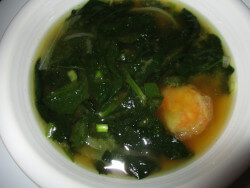
This is probably one of the simplest Korean foods to make, but the taste is one of the most complex.
Key Ingredients (for 2 servings)
Doenjang (된장 ): For this recipe, you need Doenjang, which is fermented soybean paste.
Shrimps: 3 - 4 extra-large shrimps or 2-3 jumbo shrimps (unpeeled). Frozen ones are fine.
Spinach: About 3 ounces of spinach.
Onion: Slice 1/4 - 1/2 of a medium-sized onion.
Green onion (optional): Chop one green onion.
Dasima (다시마 : sea tangle; optional for this recipe): Dasima is a type of seaweed available at Korean groceries. You need a palm-sized piece.
In a pot, add 4 cups of water and, optionally, a palm-sized piece of Dasima, and turn up the heat to high. Once water starts to boil, add the shrimps and sliced onion and keep everything in vigorously boiling water for 5 minutes. If you added Dasima, take it out and discard it at this point.
Add the spinach to the boiling mix. Once the volume of spinach gets reduced, add about 2 tablespoons of Doenjang. The amount you need depends on your taste and the brand of Doenjang. After adding Doenjang, turn down the heat to medium and cook for 10-15 additional minutes. Before removing the pot from heat, add some chopped green onion (which is optional) and black pepper.
This recipe uses shrimps, because frozen shrimps are readily available. However, the classic Korean recipe calls for clams (instead of shrimps), which tastes much better than this shrimp version. To make Clam-Doenjang Soup, add an ample number of clams (for example, 12 medium-sized clams).
Doenjang Jjigae
(된장 찌개 )
Moderate Efforts Required
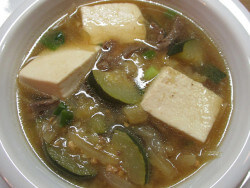
Key Ingredients (for a table of 2 people)
Doenjang (된장 ): For this recipe, you need Doenjang, which is fermented soybean paste.
Beef or Pork: Slice about 0.2 pound (one fifth of a pound) into small pieces. You can also use ground beef or pork.
Zucchini: Cut 1/2 of a medium-sized zucchini into 0.5-inch thick circles, then divide each circle to 4 wedges.
Tofu: Cut tofu into rectangular pieces with a thickness of half an inch.
Onion: Slice 1/4 - 1/2 of a medium-sized onion.
Green onion: Chop one green onion.
In a pot, add a small amount of vegetable oil and turn up the heat to high. Add the beef (or pork) slices and stir-fry them briefly. To the pot, add 3 cups of water and the sliced zucchini and onion. Wait until the water boils and continue to cook for 10 minutes. Then add 2 to 2.5 tablespoons of Doenjang (the amount depends on your taste and the brand of Doenjang) and turn down the heat to medium and cook for 5 minutes. Add the sliced tofu and chopped green onion and continue to cook for 5 additional minutes. Turn off the heat and serve.
There are “hotter” versions of this dish, which you can make by adding some red pepper flakes (고춧가루 ; Gochugaru) or Korean pepper. Korean groceries have many types of green peppers. Some of these (Jalapeno, etc.) are too strong and not recommended for this recipe. However, they also carry a type of green pepper labeled “Korean pepper”, which is a mild pepper (you need to check the label, because they look similar to other varieties). If you can find them, you can add one medium-sized Korean pepper (sliced).
Beef Jorim with Soy Sauce
(장조림 : Jang Jorim)
Moderate Efforts Required
Goes Well with American Meals
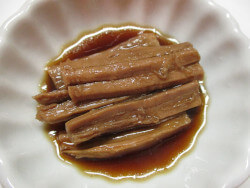
Since this side dish is usually taken out of the refrigerator and served cold, you may want to prepare a substantial amount (more than a few servings) at a time, and keep it in the refrigerator for a week or so. Serve only a small amount each time, because this is a side dish.
Key Ingredients
Beef: Start with about 0.5 pound of beef. Eye of round is traditionally the best choice for this recipe (but other cuts that are commonly used for making stews can also be used). Cut an eye of round block into chunks; each being approximately 2 inches by 1 inch with a thickness of 0.5 inch. The 2-inch length should be in the direction of the natural grain, because near the end of the procedure, you will tear up the beef by hand to make strips that are about 2-inch long — as shown in the picture. Put the chunks in a pot and add 2.5 cups of water. Boil the water over high heat without covering the pot with a lid. Once boiling, skim off the scum that may rise. Reduce the heat to medium and continue to cook for about 50 to 60 minutes with the pot partially covered with a lid. At the end of this step, the liquid would have been reduced to about 1/3 of the original volume. Remove the beef chunks and cool them down so that you can safely handle them with fingers. Tear up (shred) the beef into narrow strips with your fingers; the beef will split along its natural grain. To the liquid that is remaining in the pot, add 2 to 2.5 tablespoons of soy sauce and 1 to 1.5 tablespoons of sugar. Put the shredded beef back into the pot, turn up the heat to high and wait until the liquid begin to boil, at which point reduce the heat to medium and continue to cook for 5 additional minutes. Remove the pot from the heat and leave it at room temperature for 10-15 minutes. Transfer the content to a storage container and keep it in the refrigerator. For each meal, take out a portion and serve it cold.
Potato Jorim
(감자 조림 : Gamja Jorim)
Moderate Efforts Required
Goes Well with American Meals
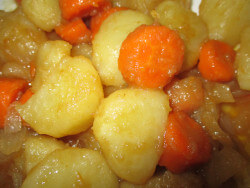
Cut 2 large (or 3 medium) potatoes into small pieces. The thickness should be about half an inch, and length and width should be around 1 to 1.5 inches. Also, cut one half of a medium-sized onion and optionally, one half of a medium-sized carrot into whichever shape you like. Put some vegetable oil in a pot and add the sliced potato, onion and carrot and set the heat at high. Stir-fry briskly in oil for half a minute. During this quick heating step, the potato will be covered with oil but only barely cooked.
Add water to the pot to partially cover the content. Reduce the heat to medium and cover the pot with a lid. Continue to heat to cook the potato with the hot water and the steam generated in the pot. Don’t forget to scrape the bottom of the pot with a wooden spatula at least several times; otherwise, the potato slices will stick to the bottom and burn.
When the potato pieces are fully cooked, add soy sauce, vinegar, sugar and black pepper to your taste. Mix them well and continue heating for additional 1-2 minutes, at which point you can turn off the heat.
Note: In the traditional recipe, soy sauce is added from the very beginning. However, in this modified recipe, soy sauce is added near the end of the procedure.
Hot & Sweet Noodle
(매운 국수 : Maeun Gugsu)
Easy and Quick
No Animal Fat
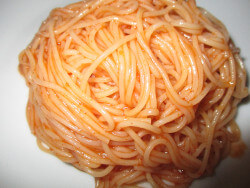
In a weekend afternoon, when you want to try something unusual but don’t want to go out, you can make a small amount of this hot, cold noodle as an appetizer or side dish. This quick recipe is an extremely trimmed down version of a classic Korean dish, Bibim Naengmyeon (비빔냉면 ), which is much more involved and requires special (buckwheat-based) noodles. Using very plain, wheat-based Korean noodles (called Somen), this recipe achieves a satisfying simulation of Bibim Naengmyeon, since it uses a similar Cho-Gochujang sauce.
Key Ingredients (for 2 appetizer-sized servings)
Somen Noodle: Somen, meaning “plain noodle”, is available at Korean groceries.
Making "Cho-Gochujang" (초고추장 ) Sauce: Cho-Gochujang is made by mixing red pepper paste (고추장 : Gochujang), vinegar and sugar. The ratio of the three ingredients is: 2.5 tablespoons of red pepper paste (Gochujang), 1 tablespoon of vinegar and 1 tablespoon of sugar. Note that the numbers given here only show the ratio. The actual amount of Cho-Gochujang you need may vary.
Preparing Cold Somen: Add water to a large pot and bring it to boil. Once the water starts to boil, add an appropriate amount of Somen noodle to the pot. Note: Compared to Italian pasta, Korean noodles are softer and release a fair amount of starch into the water during cooking. In boiling water, Korean noodles form starch bubbles, which may boil over. Have a cup of cold water ready, and each time bubbles are about to boil over, add a little bit of cold water to the boiling pot to force the bubbles to subside (you don't need to turn down the heat). Keep cooking Somen for the duration specified on the package. Near the end of the time, take out a strand and try. If it’s properly cooked, drain and then wash the noodles under cold running water. It's also a good idea to use some ice cubes to cool down the noodle faster. Drain well.
Serving: To the cold noodle, add an appropriate amount of the Cho-Gochujang sauce according to your taste; mix well before serving. Optionally, you can place one half of a hardboiled egg on top, with the yolk facing up. This dish can be enjoyed as an appetizer. Alternatively, it can be eaten along with Beef and Zucchini Noodle described below (side by side, as two separate dishes).
Beef & Zucchini Noodle
(소고기 비빔국수 : Sogogi Bibim Gugsu)
Moderate Efforts Required
Goes Well with American Meals
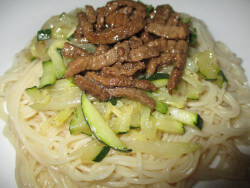
Key Ingredients (for 2 servings)
Somen Noodle: Somen, meaning “plain noodle” in Korean, is available at Korean groceries.
Beef: Slice about 0.2 pound (one fifth of a pound) of beef into long strips. Stir-fry them in a pan oiled with vegetable oil. Transfer them to a small bowl and season with soy sauce and sugar; leave them to cool down to room temperature.
Zucchini and Onion: Julienne one half of a medium-sized zucchini and slice one half of a small-sized onion. Stir-fry them in a pan oiled with vegetable oil. Season with salt and pepper; leave them to cool down to room temperature.
Preparing Cold Somen: Add water to a large pot and bring it to boil. Once the water starts to boil, add an appropriate amount of Somen noodle to the pot. Note: Compared to Italian pasta, Korean noodles are softer and release a fair amount of starch into the water during cooking. In boiling water, Korean noodles form starch bubbles, which may boil over. Have a cup of cold water ready, and each time bubbles are about to boil over, add a little bit of cold water to the boiling pot to force the bubbles to subside (you don't need to turn down the heat). Keep cooking Somen for the duration specified on the package. Near the end of the time, take out a strand and try. If it’s properly cooked, drain and then wash the noodles under cold running water. It's also a good idea to use some ice cubes to cool down the noodle faster. Drain well.
Seasoning Cold Somen: To the cold noodle, add soy sauce, vinegar and sugar to your taste and mix well.
Serving: In a bowl, put the seasoned noodle. On top of the noodle, place the cooked zucchini and onion first and then the cooked beef.
Boiled Calamari / Squid
(삶은 오징어 : Salmun Ojingeo)
Easy and Quick
Goes Well with American Meals
Low in Animal Fat
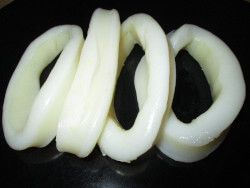
Did you know that frozen calamari, readily available at most American supermarkets, is a perfect material for a delicious Korean appetizer / side dish? This dish is extremely simple to make.
Start boiling water in a pot. Meanwhile, prepare the calamari / squids that you.
If you purchased calamari / squids that are cleaned but not frozen, wash them and cut them into rings. Add the rings into boiling water and cook for 4-5 minutes. Drain them; do not wash the rings in cold water. Serve the warm rings with Cho-Gochujang as a dipping sauce (see below).
If you purchased calamari / squids that are cleaned and frozen, you can remove them from the package and put them directly in boiling water. Water will be cooled down initially but will begin to boil again several minutes later; counting from this point, wait about 4-5 minutes and drain well. Put the calamari / squids on a cutting board. Hold the calamari / squids with a fork (since they are too hot to touch), and cut them into rings. Serve the warm rings with Cho-Gochujang as a dipping sauce.
Making "Cho-Gochujang" (초고추장 ) Sauce: Cho-Gochujang is made by mixing red pepper paste (고추장 : Gochujang), vinegar and sugar. The ratio of the three ingredients is: 2.5 tablespoons of red pepper paste (Gochujang), 1 tablespoon of vinegar and 1 tablespoon of sugar. Note that the numbers given here only show the ratio. The actual amount of Cho-Gochujang you need may vary.
Hot & Sweet Seaweed
(미역 무침 : Miyeok Moochim)
Easy and Quick
Goes Well with American Meals
No Animal Fat
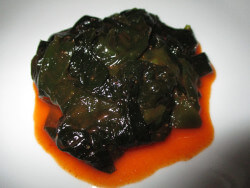
This easy-to-make side dish is a great appetite enhancer.
For this recipe, you will need Miyeok (미역 ), a type of seaweed, which you can buy at Korean groceries. It is packaged in plastic packages in the form of dried clumps.
How to Prepare Miyeok (미역): Take out Miyeok from the package and put it in a large bowl. The amount you need is about half the size of an adult’s fist. Pour 3 cups of cold water. Leave Miyeok in the water for about 20 minutes. The volume of Miyeok will expand greatly in water – you will be surprised (see pictures). After 20 minutes or so, Miyeok turns into long, soft bands. Using kitchen scissors, cut Miyeok into short pieces (each piece should be shorter than 2 inches). If you don’t have kitchen scissors, you can use a knife, but it's more difficult to cut the slippery Miyeok with a knife. Make sure that there is no long piece remaining.
Add fresh cold water to a pot and bring it to boil. Add the short Miyeok pieces into the boiling water and wait for about 7-8 minutes. Drain and rinse them with cold water. This dish will be eaten cold, so you can add some ice cubes at this step to speed up the cooling process. When the Miyeok pieces are sufficiently cooled down, squeeze out water as much as you can by tightly holding the Miyeok with your hands. Transfer them to a bowl.
Making "Cho-Gochujang" (초고추장 ) Sauce: Cho-Gochujang is made by mixing red pepper paste (고추장 : Gochujang), vinegar and sugar. The ratio of the three ingredients is: 2.5 tablespoons of red pepper paste (Gochujang), 1 tablespoon of vinegar and 1 tablespoon of sugar. Note that the numbers given here only show the ratio. The actual amount of Cho-Gochujang you need may vary.
Add an appropriate amount of the Cho-Gochujang sauce to the cold Miyeok and mix well. The amount of Cho-Gochujang sauce you want to add depends on your taste as well as the amount of Miyeok you prepared and the amount of water remaining on Miyeok. If you like cucumber, you can include julienned English cucumber for additional flavor. After mixing, keep it in the refrigerator until you are ready to serve it.
Seaweed & Cucumber with Mustard
(미역 오이 무침 : Miyeok Oee Moochim)
Easy and Quick
Goes Well with American Meals
No Animal Fat
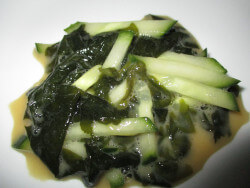
The flavors of Miyeok and cucumber complement each other very well, especially in the mustard sauce used in this recipe.
For this recipe, you will need Miyeok (미역 ), a type of seaweed, which you can buy at Korean groceries. It is packaged in plastic packages in the form of dried clumps.
How to Prepare Miyeok (미역): Take out Miyeok from the package and put it in a large bowl. The amount you need is about half the size of an adult’s fist. Pour 3 cups of cold water. Leave Miyeok in the water for about 20 minutes. The volume of Miyeok will expand greatly in water – you will be surprised (see pictures). After 20 minutes or so, Miyeok turns into long, soft bands. Using kitchen scissors, cut Miyeok into short pieces (each piece should be shorter than 2 inches). If you don’t have kitchen scissors, you can use a knife, but it's more difficult to cut the slippery Miyeok with a knife. Make sure that there is no long piece remaining.
Add fresh cold water to a pot and bring it to boil. Add the short Miyeok pieces into the boiling water and wait for about 7-8 minutes. Drain and rinse them with cold water. This dish will be eaten cold, so you can add some ice cubes at this step to speed up the cooling process. When the Miyeok pieces are sufficiently cooled down, squeeze out water as much as you can by tightly holding the Miyeok with your hands. Transfer them to a bowl.
As for the cucumber, English cucumber is better for this recipe. Slice a 1/3 of an English cucumber into julienne strips and add them to the bowl.
Making the Mustard Soy Sauce: In a tiny bowl, add 1 tablespoon of Dijon Mustard, 2 teaspoons of vinegar, 1 teaspoon of soy sauce and 2 teaspoons of sugar. Mix well.
Mix the cold Miyeok and cucumber slices with the sauce, and keep it in the refrigerator until you are ready to serve it.
Kimchi Jeon
(김치 전 )
Easy and Quick

This is a side dish made with Kimchi but not Kimchi at its prime of taste. It specifically calls for sour (over-ripe) Kimchi (sour Napa cabbage Kimchi, not radish Kimchi). Rinse 1 cup of sour Kimchi with cold water; gently squeeze out excess water. Chop the Kimchi into small pieces and put them in a bowl. Add a small amount of beef (0.1 - 0.2 pound) cut into narrow strips (you can also use ground beef). To bind Kimchi and beef, add one egg and 2 tablespoons of flour and mix everything well.
Add vegetable oil in a pan so that the pan is covered with a layer of oil. Set the heat at medium high and wait a couple of minutes. Using two spoons, transfer a table-spoonful of the mix to the pan and shape it into a round pellet. Try to form a flat lump roughly in the shape of a cookie (about 1.5 inch in diameter). A few pellets can be cooked in a pan at the same time. Flip each pellet a few times until the they get golden brown on both sides. Transfer them to a plate and serve. No sauce is necessary, but if you want, you can use soy sauce as a dipping sauce.
Kimchi Noodle
(김치 국수 : Kimchi Gugsu)
Easy and Quick
No Animal Fat
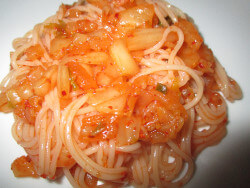
Making this refreshing cold noodle is an excellent way to escape from the routine. The recipe is very simple and it uses sour (over-ripe) Kimchi (Napa cabbage Kimchi, not radish Kimchi).
Key Ingredients (for 2 servings)
Somen Noodle: Somen, meaning “plain noodle” in Korean, is available at Korean groceries.
Chopping and Seasoning Kimchi: Chop 1.5 cups of sour Kimchi and put it in a bowl. Then add 1 tablespoon of sugar, 1 teaspoon of sesame oil and 2 teaspoons of crushed sesame; mix well.
Preparing Cold Somen: Add water to a large pot and bring it to boil. Once the water starts to boil, add an appropriate amount of Somen noodle to the pot. Note: Compared to Italian pasta, Korean noodles are softer and release a fair amount of starch into the water during cooking. In boiling water, Korean noodles form starch bubbles, which may boil over. Have a cup of cold water ready, and each time bubbles are about to boil over, add a little bit of cold water to the boiling pot to force the bubbles to subside (you don't need to turn down the heat). Keep cooking Somen for the duration specified on the package. Near the end of the time, take out a strand and try. If it’s properly cooked, drain and then wash the noodles under cold running water. It's also a good idea to use some ice cubes to cool down the noodle faster. Drain well.
Serving: To the cold noodle, add the seasoned chopped Kimchi and mix well. Jang Jorim is a side dish that goes well with this cold noodle.
Baked Korean Sweet Potato
(군고구마: Goon Goguma )
Easy
No Animal Fat
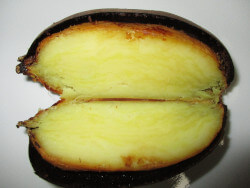
A Korean sweet potato (고구마 : Goguma) is like a cake all prepared by nature only to be dug up from the earth. During baking, Korean sweet potatoes generate a wonderful chestnut-like aroma. And the taste is also closer to roasted chestnut than anything else. Baked Korean sweet potato (군고구마 : Goon Goguma; meaning “Baked Goguma”) is a popular street food in Korea, especially in the winter. You can buy Goguma at Korean groceries.
Directions: Preheat the oven to 425° F. Wash Korean sweet potatoes and place them on an iron rack in a pan. Bake them for about 40 minutes at 425° F; then reduce the temperature to 400° F and continue to bake for an additional 30 minutes. The total baking time varies depending on the size of Korean sweet potatoes. Carefully remove the pan from the oven and let the Korean sweet potatoes cool for some time. Serve them hot with a fork and a knife. Most people enjoy them without any sauce or condiments; some say Kimchi goes very well with baked Goguma.